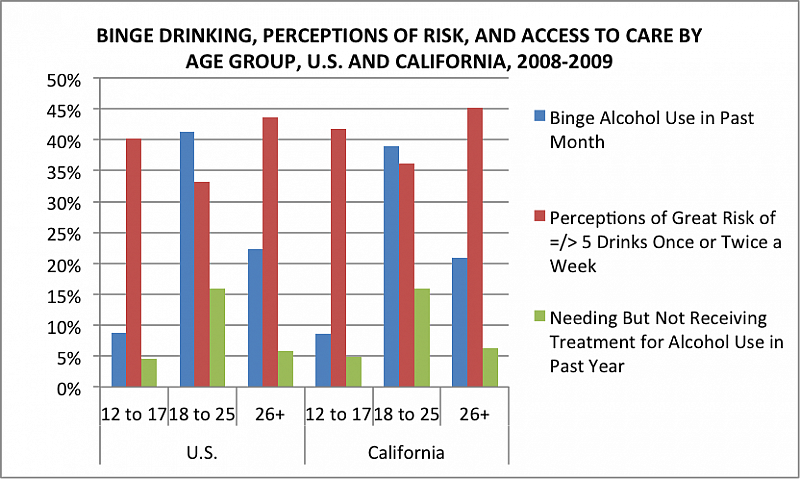“Emerging Young Adults” Adrift in Perfect Storm of Health Risks

You’ve likely heard them called “young invincibles” – the twenty-somethings that don’t have any health insurance. As they gain independence from their parents and try to find their footing, health insurance is not often their top priority.
In our new study -- Health Conditions, Behaviors, Risks and Services Among Adolescents (12–17), Emerging Young Adults (18–25) and Young Adults (26–34) in United States and California – we found that those ages 18 to 25 years old have the least access to health care and have the highest uninsured rate in the United States even after changes with the Affordable Care Act. They occupy the space between adolescence and young adulthood -- separating from home and parents, but in many instances not yet completely independent adults. It is a potentially precarious time of life.
There’s also evidence that this age group, which we’ve dubbed “Emerging Young Adults,” displays characteristics that in previous decades were more likely found in adolescents. As I looked at some of the data it appears that it was actually our emerging young adults that were “the new adolescents,” because they exhibited the same type of risk taking behaviors characteristic of teenagers in the 60s and 70s.
This is in keeping with other research on the subject. Studies sponsored by the National Institute of Mental Health revealed that the cognitive centers are still developing into young adulthood. Sociologists discovered that young adults are reaching “prior defined” milestones much later including completing school, leaving home, becoming financially independent, marrying and having a child. In 1960: 77% women and 65% of men at 30 reached these five milestones. Among 30-year-olds in 2000, <50% of women and 1/3rd of men had done so.
I began a two year journey with help from the California Wellness Foundation, the Saban Research Institute of Children’s Hospital of Los Angeles and the Leonard D. Schaeffer Center for Health Policy and Economics at the University of Southern California to explore what is happening with this population in terms of health risks, perception of risks and access to care -- a hot important topic right now nationally.
Our small research team explored all the important national data that we could find on comparing health risks and access to services among three different age groups: 12-17 (Adolescents), 18-26 (Emerging Young Adults) and 26-34 (Young Adults). We examined: demographics, mortality, injuries, mental health, substance abuse, reproduction health, sexually transmitted diseases, chronic diseases, health prevention, and access, utilization and cost of services. We culled data from many national sources and California sources. These included data from CDC, National Center for Health Statistics, National Health Interview Survey, National Survey for Family Growth among many, many others.
So what did we find?
First, a disclaimer: The majority of individuals in all of these age groups from teens to young adults have their act together and avoid most of these risks or the serious ones. However, we did find that the health status of emerging young adults from their 18th to 26th birthdays is a major concern facing our nation. These “new adolescents”:
• face greater behavioral and non-behavioral health risks than either adolescents aged 12-17 or young adults aged 26-34. For example, emerging young adults have the highest rates of motor vehicle injury and death, homicide, mental health problems, sexually transmitted disease and substance abuse;
• compared to those two age groups, emerging young adults often have the lowest perception of risk; and
• this age group has the least access to care and has the highest uninsured rate in the United States even after health reform.
Our assessment from these findings is that “emerging young adults are adrift in the perfect storm of health risks.”

The graphic to the right offers just one example of this perfect storm. Emerging young adults have the highest prevalence of binge drinking (blue), the lowest perception of high risk (red) and the highest rate of needing but not receiving treatment for this problem (green).
Emerging young adults are the most uninsured age group in the United States, often losing their insurance when they graduate high school or college. Far from the perception that they only need catastrophic coverage, these young invincibles need comprehensive health coverage. Although the Affordable Health Care Act has helped this situation, a Gallup-Healthway poll last year estimated a small decline of uninsured emerging young adults from 28% uninsured 18- to 25-year-olds fall 2010 to 24.2% in second quarter of 2011.
As this report demonstrates -- this age group needs access to broad health coverage to prevent significant negative health outcomes and treat acute and chronic medical conditions.
Our goal in producing this report is to provide health care providers, health care networks and vendors, institutions, and policy makers with the data they need to make informed decisions about broad health care coverage and health prevention interventions in emerging young adults. A national emerging young adult health agenda -- including thoughtful health care research, programs and national and state policies regarding delivery and access to health care -- must be developed for this at risk age group.
Help me with your thoughts on making these goals happen!
I am a professor of pediatrics and medicine at the Keck School of Medicine of USC since 1979. I directed the academic programs and teen clinic at Children’s Hospital of Los Angeles for 17 years and the last 18 years I have been the executive director of the Engemann Student Health Center, a senior associate dean of Student Affairs, and Chief of the Division of College Health. I have been a past president of the Society for Adolescent Health and Medicine and recipient of their Lifetime Achievement Award in adolescent health. I have written and edited the major textbook in the field - Adolescent Health Care, A Practical Guide, now in its 5th edition. My free online curriculum in adolescent and young adult health (www.usc.edu/adolhealth) is accessed annually by over 250,000 individuals worldwide.
Thank you for your interest. For your questions I am available at: neinstei@usc.edu.

